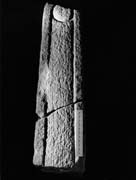Select a site alphabetically from the choices shown in the box below. Alternatively, browse sculptural examples using the Forward/Back buttons.
Chapters for this volume, along with copies of original in-text images, are available here.
Object type: Part of cross-shaft, in two joining pieces [1]
Measurements: H. 51 cm (20 in); W. 23.2 > 19 cm (9.2 > 7.5 in); D. 12.8 > 10.2 cm (5 > 4 in)
Stone type: Medium-grained, micaceous, feldspathic, reddish-yellow (7.5YR 6/8) sandstone; see no. 1.
Plate numbers in printed volume: 490-493
Corpus volume reference: Vol 3 p. 145-146
(There may be more views or larger images available for this item. Click on the thumbnail image to view.)
The shaft tapers noticeably; there is no evidence of a cross-head.
A (broad): There is a broad, flat edge moulding (which may once have been ornamented) which develops into a pair of semicircular arches at the top and joins a central moulding. Within the two arched panels are mirror image runs of lightly carved plant-scroll accommodated to the tapering panels. The plant is apparently a spiral scroll, each volute having a pendant leaf filling the triangular space. Within some of the scrolls are rosette berry bunches. The carving is in very low relief.
B and D (narrow): There is a broad plain edge moulding formed by a deeply incised line which develops into an arch at the top, containing a circular terminal.
C (broad): The mouldings are the same as face A's. The pair of arched panels have an inner moulding, slightly modelled, and within are a few diagonal marks which may be vestigial plant-scroll.
The form of the shaft is rare and local: the closest parallel is the fragmentary Levisham 3 (Ills. 644–7), which is not as elaborate, and a more complete example, Kirby Misperton 1 (Ills. 508–12), reveals the original shouldered profile. The shouldered shaft is a late variety in the north-west, but the plant-scroll here indicates a ninth-century date. There would have been a narrower neck to the shaft, to judge from Kirby Misperton 1, which shares the arched panels of the threesome and has early forms of interlace.



